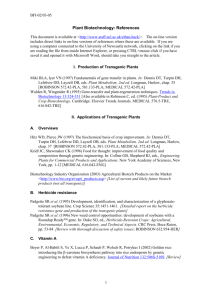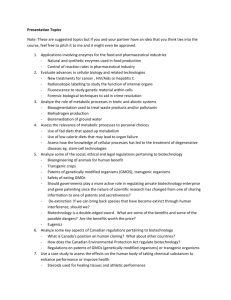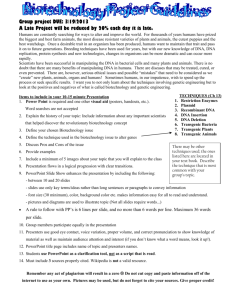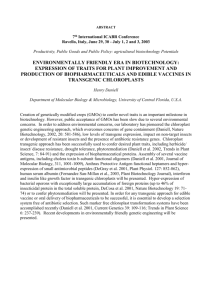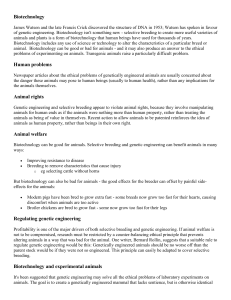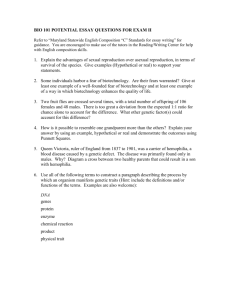Public perceptions of transgenic animals
advertisement
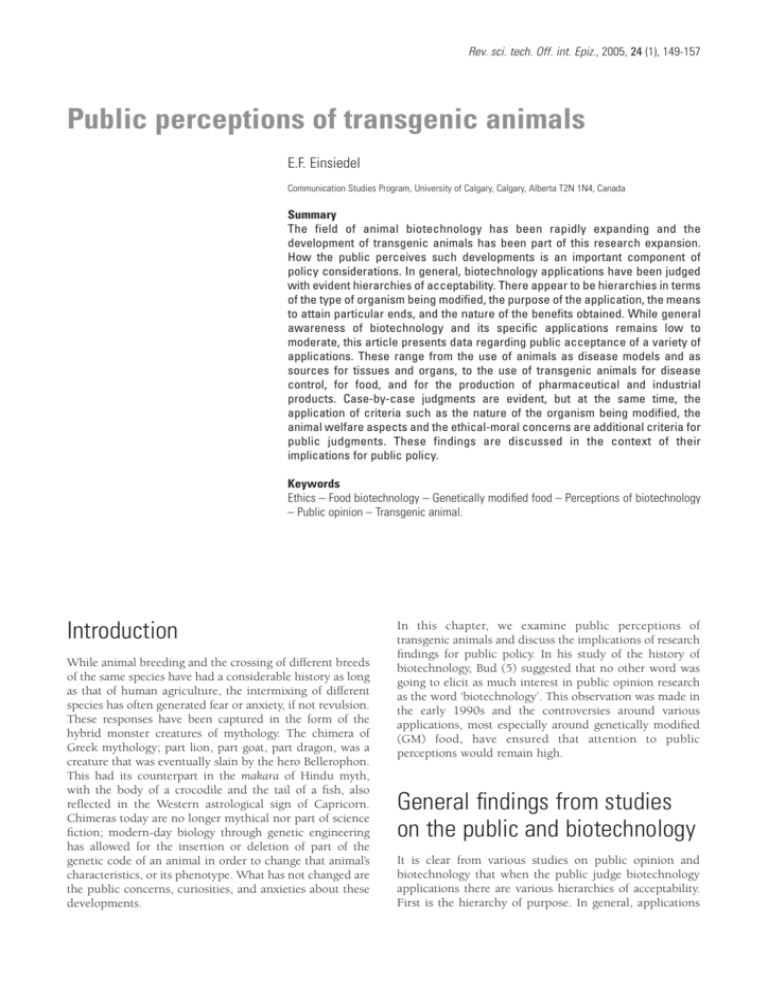
Rev. sci. tech. Off. int. Epiz., 2005, 24 (1), 149-157 Public perceptions of transgenic animals E.F. Einsiedel Communication Studies Program, University of Calgary, Calgary, Alberta T2N 1N4, Canada Summary The field of animal biotechnology has been rapidly expanding and the development of transgenic animals has been part of this research expansion. How the public perceives such developments is an important component of policy considerations. In general, biotechnology applications have been judged with evident hierarchies of acceptability. There appear to be hierarchies in terms of the type of organism being modified, the purpose of the application, the means to attain particular ends, and the nature of the benefits obtained. While general awareness of biotechnology and its specific applications remains low to moderate, this article presents data regarding public acceptance of a variety of applications. These range from the use of animals as disease models and as sources for tissues and organs, to the use of transgenic animals for disease control, for food, and for the production of pharmaceutical and industrial products. Case-by-case judgments are evident, but at the same time, the application of criteria such as the nature of the organism being modified, the animal welfare aspects and the ethical-moral concerns are additional criteria for public judgments. These findings are discussed in the context of their implications for public policy. Keywords Ethics – Food biotechnology – Genetically modified food – Perceptions of biotechnology – Public opinion – Transgenic animal. Introduction While animal breeding and the crossing of different breeds of the same species have had a considerable history as long as that of human agriculture, the intermixing of different species has often generated fear or anxiety, if not revulsion. These responses have been captured in the form of the hybrid monster creatures of mythology. The chimera of Greek mythology; part lion, part goat, part dragon, was a creature that was eventually slain by the hero Bellerophon. This had its counterpart in the makara of Hindu myth, with the body of a crocodile and the tail of a fish, also reflected in the Western astrological sign of Capricorn. Chimeras today are no longer mythical nor part of science fiction; modern-day biology through genetic engineering has allowed for the insertion or deletion of part of the genetic code of an animal in order to change that animal’s characteristics, or its phenotype. What has not changed are the public concerns, curiosities, and anxieties about these developments. In this chapter, we examine public perceptions of transgenic animals and discuss the implications of research findings for public policy. In his study of the history of biotechnology, Bud (5) suggested that no other word was going to elicit as much interest in public opinion research as the word ‘biotechnology’. This observation was made in the early 1990s and the controversies around various applications, most especially around genetically modified (GM) food, have ensured that attention to public perceptions would remain high. General findings from studies on the public and biotechnology It is clear from various studies on public opinion and biotechnology that when the public judge biotechnology applications there are various hierarchies of acceptability. First is the hierarchy of purpose. In general, applications 150 intended to generate health and medical benefits are viewed most positively. This is followed by applications for environmental benefits. Food biotechnology has generated more concerns for a variety of reasons. When the purpose achieves some good to society, greater support for the application is elicited than when the purpose is seen as benefiting more individual (non-utilitarian) pursuits. For example, among Japanese respondents who were asked whether they approved of categories of genetically engineered animals, 65% approved of ‘bacteria to clean up oil spills’, a more even split was observed for ‘cows that produce more milk’ (42% approving to 40% disapproving), while only 19% approved of ‘larger sport fish’ (32). Even within the medical realm, not all medical applications are regarded equally. For example, while Europeans and North Americans view genetic testing with approval, there is much less approval for such applications as xenotransplantation (20, 22). An examination of public views on molecular farming exhibits this same pattern. Among Americans, 81% agree that designing biotech crops to make affordable drugs is a good idea, but only 49% agree that genetically engineering animals for drugs is a good idea. (40). These examples demonstrate that while curing human disease provides a worthy rationale for genetic engineering research, other imperatives are considered in overall judgments. The second hierarchy observed is on the object of the manipulation. Manipulation of micro-organisms generates the least concern, followed by plants. When it comes to genetic modification of animals and particularly humans, more objections are registered (17, 18, 45). Issues of concern One area of concern is the moral status of animals. This has sprung from the reflections of philosophers (43, 44), the advocacy of animal rights and animal welfare organisations, and the incorporation of pets as part of the family circle (1). These factors have now made the status of animals a mainstream concern (43). Studies of public views on animal experimentation have demonstrated that account is taken of the purpose of the experiment, whether there is unnecessary suffering of the animals, whether basic animal welfare is adhered to, and whether alternatives are available (1, 38). The guidelines on the care of animals used in research, which are well established in many countries, are an indicator of the institutionalisation of this care. The United Nations World Charter for Nature declared: ‘every form of life is unique, warranting respect regardless of its worth to man, and, to accord other organisms such recognition, man must be guided by a moral code of action.’ (46). While not universally Rev. sci. tech. Off. int. Epiz., 24 (1) accepted, this resolution propounds a common scale of value that both human and non-human life have intrinsic merit and worth. A second area of concern is the boundary constructed between what is considered ‘natural’ and ‘unnatural’. To many people, the crossing of species boundaries is ‘unnatural’. This becomes especially problematic when higher life forms are involved. This concern is not just limited to the general public; even among some scientists, this issue is problematic (12, 30). Another consideration for some revolves around offending human dignity, particularly in the case of human-animal chimeras. As argued by Johnston and Eliot (26), this notion suggests that our collective sense of humanity is compromised when we refuse to consider our obligations to the chimera or when we do not acknowledge how such activities reflect on the people or societies who create such creatures. A third area of concern is related to the consequences of genetic modification. Such consequences can be defined in terms of positive or negative effects for humans and for the environment. These consequences are usually assessed by consideration of the factors for and against: there may be perceived benefits for the consumer in terms of cheaper prices or better nutrition; for people with illnesses, the benefit could involve greater availability of drugs, lower prices, or reduced mortality. On the other hand, concerns have also been expressed about risks from long-term impacts. The uncertain consequences to human health were identified as key concerns among American consumers in focus groups on biotechnology (31). Similar concerns were identified among the British public (37). For the citizen, the benefits may revolve around societal considerations, from health care costs to more equitable delivery of goods and services. These advantages are weighed against perceived risks or costs to the individual and to society (1). Consequences to the environment from transgenic animals can also be taken into account. In the United Kingdom, the Agriculture and Environment Biotechnology Commission has suggested that the international movement of cloned and GM animals should be monitored to prevent smuggling, maintain consumer choice, and protect the environment (3). Increasingly, consequences on a global scale have become a significant factor in domestic calculations. When new hybrids are created, raising questions about environmental impacts, such issues are not limited by national borders. This will be a factor with transgenic animals, when considering their environmental impact or when concerns arise about the proliferation of disease. 151 Rev. sci. tech. Off. int. Epiz., 24 (1) Public awareness about transgenic animals In general, public awareness levels about transgenic animals are low. One general indicator of awareness is reflected in the general level of understanding about animal and human genetics and images about transgenic animals. In national surveys in the United States of America (USA) and Canada and among European countries, a series of questions were asked requiring ‘true’ or ‘false’ responses. Three items relating to genetics and animals provide a partial picture of the understanding of different peoples and how they ‘imagine’ GM animals (Table I). The results provide an indication of the general beliefs in North American and Europe about similarities between human and non-human genetic make-up and the possibilities and potential outcomes of genetic engineering. Attitudes to genetically modified and cloned animals It is important to recognise that distinctions between the cloning and genetic engineering of animals may not necessarily be made by the public. It is also in these areas where scientists and the general public are in some disagreement. A recent survey of American consumers and scientists showed that both groups approved of research relating to biotechnology generally, stem cell research, and genetic modification of plants (30). There was also consensus among both groups about human cloning: both disapproved. However, while a significant majority of consumers and scientists were in agreement that both cloning and genetic modification of animals raised at least some moral and ethical issues, consumers were much more likely to disapprove of such research than scientists. Thus, the results of this survey were that approximately 75% of consumers and 70% of the scientists surveyed said that this type of research did raise some moral and ethical questions. However, consumers were much less likely than scientists to approve of the genetic modification of animals (only 21% of consumers approved in contrast to 68% of scientists). A similar pattern was found for cloning animals (25% of consumers approved in contrast to 60% of scientists) (30). Specific applications for transgenic animals Transgenic animals as disease models In Switzerland, a ‘gene protection initiative’ was the subject of a national referendum which would have made illegal the use of transgenic animals in research. The final result was that two-thirds (67%) of the voters opposed this initiative. Proponents of the initiative included a diverse coalition of environmental, animal-rights and political groups, which collected 111,000 signatures to bring the proposal to a vote (28). The failure of this initiative was attributed, by some, to the active information campaign carried out by scientists from universities and from the private sector. Guidelines have been put in place that extend the same protection to transgenic animals as is already afforded to conventional laboratory animals (6). The benefits of using transgenic animals include the possibility of the replacement of higher species by lower species, for example: – through the development of disease models in mice rather than in dogs or non-human primates – through the precision gained when studying transgenic animal disease models (e.g. the oncomouse) in comparison to traditional animal models – through the reduction in the number of animals used to study human disease. Concerns have remained, however, about the welfare of transgenic animals for laboratory use. These include: – the extent of discomfort experienced by parent animals during the experimental procedures – the effect of the expression of the modified gene or transgene on the created animal – the effects on their progeny (34, 35, 36). Table I Public understanding of genetics: responses to true and false statements about genetics in Canada, the United States of America and Europe (13, 19) Statement Percentage of respondents who provided the correct response Canada United States of America Europe Animal genes cannot be transferred into plants (False) 51.2 48.3 26 More than half of human genetic make-up is identical to that of chimpanzees (True) 65.0 54.6 52 Genetically modified animals are always bigger than ordinary ones (False) 62.3 57.2 38.6 152 There also remains some concern that with advances in transgenic animal technologies the number of animals used for research may actually increase rather than be reduced. This would be because of the wider range of diseases and conditions it would be possible to explore and because of the increasing number of uses for transgenic animals, in agricultural, pharmaceutical and industrial production units (6). Transgenic animals for drug and industrial production Producing pharmaceutical proteins can be prohibitively expensive when it is done through the large-scale culture of human cells. Some bacteria and plants can be used as production mechanisms, but in some instances, the use of animals is the only way to ensure appropriate levels of biological activity. The protein alpha-1-antitrypsin, normally produced in the liver, is required for the treatment of lung diseases such as emphysema or cystic fibrosis. While this protein can be produced in transgenic plants, the product obtained does not have certain carbohydrate elements and is processed in the bloodstream at much faster rates than that produced by the liver. The more effective protein version is produced by animals modified to secrete the human protein in their milk (4). Americans are more supportive than Canadians of the use of GM animals to produce higher quality industrial products. A survey of both groups used the example of ‘goats that would produce milk containing spider silk that is stronger and lighter than any product currently in use, that can be used to make things like bullet-proof vests or surgical thread’. Sixty percent of Americans were supportive of this application in comparison to 50% of Canadians (10). Again, the plant-animal hierarchy is evident for the production of pharmaceutical and industrial proteins: the public are more likely to support the use of transgenic plants as bioreactors. Transgenic animals for environmental uses In general, environmental applications tend to be positively received by the public, particularly bioremediation (10). Among Europeans, ‘developing GM bacteria to clean up oil slicks or dangerous chemicals’ was viewed as ‘useful’ by 60%, risky by 40%, and morally acceptable by 50% of the respondents. When asked whether this application should be ‘encouraged’, 50% expressed agreement (21). The general public also express concerns about long-term impacts. When asked about their primary concern regarding different biotechnology applications such as Rev. sci. tech. Off. int. Epiz., 24 (1) GM food, GM health products, and GM environmental applications, between 45% and 50% of Americans and Canadians mentioned long term risks to the environment as their primary concern, followed by long-term risks to health (10, 40). However, the hierarchies of acceptance discussed earlier also hold in this area. Transgenic animals for disease control Mice, which are major pests in Australia, were targeted for control by scientists who altered the genes of the mousepox virus (25). The creation of an unusually virulent strain of mousepox resulted in public attention and concern (11). The public in the USA also expressed concern about genetically modifying insects to prevent them from carrying disease. Only 39% agreed with the idea of modifying insects such as mosquitoes for disease prevention (39). In this case, the choice presented in the survey provided both benefit and risk: ‘some scientists believe they may be able to genetically modify mosquitoes so that they can no longer carry the malaria virus. Other scientists worry that genetically engineered insects like mosquitoes could have unforeseen possibly risky, consequences if they are released into the environment. Do you strongly agree, somewhat agree, somewhat disagree, or strongly disagree with the idea of genetically modifying insects to prevent them from carrying diseases?’ (39). In this instance, it is possible that given the insignificant incidence of malaria in industrialised countries, the perceived environmental risks can easily outweigh the perceived benefits. Transgenic and cloned animals as food Perhaps as a reflection of their precautionary stance towards GM food, the concern of the public is further reflected and perhaps even emphasised more strongly with transgenic animals as food. Only 25% of Canadians and approximately 33% of the public in the USA, support the use of cloned animals as a source of food (10). The USA Food and Drug Administration (FDA) imposed a voluntary moratorium for several years on introducing cloned animals into the food chain. More recently, the FDA released a draft document as an initial step towards authorising the use of cloned animals and their products for human consumption. This document concluded that cloned animals were safe to eat, but also recommended the continuation of the voluntary moratorium on such products (15). In Canada, Health Canada considers that cloned animals for food fall under the definition of ‘novel food’; making pre-market assessment requisite for such products. However, recognising that there was insufficient data to guide pre-market assessment, Health Canada similarly imposed a moratorium until such data to guide this assessment become available (24). 153 Rev. sci. tech. Off. int. Epiz., 24 (1) An earlier experience with GM animals for food may also be indicative of public anxieties and regional differences. The use of recombinant bovine somatotropin or bovine growth hormone to boost milk production generated controversy in the early to late 1990s. Despite the ruling of the FDA in 1993 that milk and meat from recombinant bovine somatotropin (rBST)-treated cows were safe for human consumption, the USA Congress voted for a temporary moratorium in response to consumer concerns (2, 9). Despite numerous consumer surveys suggesting that purchases of milk would drop if sourced from GM cows, subsequent studies on aggregate milk consumption showed no effect (2). These results were attributed to confidence in the regulatory system in the USA and the absence of reports of harm. However, for Europeans, hormone-treated cows remain unacceptable and in Canada, the use of rBST in cows remains prohibited. Xenotransplantation Certain animals such as pigs can also be genetically modified to become viable source animals for tissues and organs for human transplants. Given shortages in most countries for organs, the development of other medical options has become critical. Pigs have been genetically engineered to delete the gene responsible for the human rapid immune rejection response. Cloning then allows the creation of large herds of these modified ‘knock-out’ pigs. However, the social-ethical concerns loom large in the public mind (22). A national survey on xenotransplantation in Canada showed that while a majority supported the use of animals in medical research (66% found this research ‘acceptable’), only 48% found acceptable ‘the use of animals as a source of living cells, tissues or organs to prolong human life’ (8). The risk to the population at large has remained a primary concern to the public. Ethical objections to xenotransplantation are also prevalent. Citizen forums engaged in a public consultation on whether Canada should proceed with clinical trials on this technology. They discussed the following concerns: xenotransplantation is ‘unnatural’ and may be contrary to some religions; the right to ‘meddle with nature’ was mentioned as problematic by some; and the invasiveness of procedures for animals was also raised. A few concerns were voiced about the potential stigmatisation of the animal tissue recipient (8). The recent outbreaks of severe acute respiratory syndrome and avian influenza are sobering reminders that animal viruses can cause disease in humans. The spread of disease by infected humans can quickly cause a global problem, with significant economic and public health consequences. Other problems could also arise, given an increasingly mobile patient community. For example, with variable access to health care, possibilities for medical care tourism and transplant tourism increase. These challenges have pointed to the importance of developing policy approaches that are not just applicable domestically but also harmonised internationally, a point recognised by the more informed public (8). Other uses of transgenic animals In 2003, a fluorescent fish, called the ‘glo-fish’ by the company marketing this product, was developed for sale in pet stores in the USA, raising concerns among consumer and environmental groups (27). In the state of California, the Department of Fish and Game banned the possession, sale and transport of genetically engineered fish, but this transgenic fish was legal in the rest of the country. Coverage in the San Francisco Chronicle when this decision was made reflected the issues raised by those opposed to transgenic fish: one of the Commissioners suggested that this was an example of ‘science gone wrong’, environmental groups argued that genetically engineered fish would ‘wreak havoc on the state’s environment’, and other groups raised the issue of the cost-benefit implications and said that the risk was ‘too great for something as trivial as a pet’ (33). In Canada, it is the manufacture and importation of this fish that is covered by regulation, as the fish is considered a ‘new substance’ under the Canadian Environmental Protection Act of 1999. Such organisms cannot be manufactured or imported without notifying Environment Canada, a process which then triggers an assessment of risk that is performed in accordance with the New Substances Notification Regulation of this Act (7). For these types of transgenic animals, whose purposes are viewed as ‘less important’ by the public, the benefit quotient is such that approval levels tend to be lower. In Japan, genetic engineering to produce ‘larger sport fish’ was approved by 19%; this contrasts with 65% expressing approval for GM bacteria to clean up oil spills (32). Patents and transgenic animals In general, consumers have expressed support for the principle of patenting, including the patenting of genes and gene sequences (41). However, the hierarchy effect again comes into play with the patenting of higher life forms. When the Canadian Court of Appeals agreed with the patentability of the Harvard oncomouse (a decision since overturned by the Supreme Court of Canada), about 50% of Canadians said they were not comfortable with the Appeals Court decision. When asked ‘is it okay for someone to have a patent on a new plant modified through the use of biotechnology’, 66% were in agreement. However, only 30% agreed that ‘granting a patent on an animal modified through the use of biotechnology is no 154 different than granting a patent on a consumer product’. Furthermore, 66% agreed that ‘we should not grant patents on a new species of guinea pig that includes human genes’ and the same majority were in agreement that patents should not be granted on ‘a new species of chimpanzee that includes human genes’ (14). The policy implications All potential applications of biotechnology-derived animals are subject to considerable research, but the one which causes the most controversy is their use in commercial products. Not only do these applications generate controversy and public discomfort; there is a broader range of values that come into play with transgenic animals, beyond issues of safety and benefits. In the present research review, a description of research findings on public perceptions on biotechnology applications is presented and the way in which these perceptions are modulated by a variety of factors is discussed. The general public seem to take a utilitarian view of animal research for medical applications, i.e. animal experimentation is justified if it leads to considerable benefits for large numbers of people. However, when it comes to using GM animals in this realm, whether for research, as a source of pharmaceuticals, or as a source of cells, tissues and organs, the judgments the public make become more complex. Considerations importantly include the purpose for the modification. When benefits outweigh the risks, this can sometimes advance the case for the application. However, such utilitarian judgments are not sufficient for many members of the public. In addition to the reasons for genetic modification, a hierarchy for animals plays a further role in public judgments: the higher the life-form, the greater the role of other considerations. Animal welfare concerns appear to be increasingly prevalent the more closely the animals are related to humans. Concerns are also more significant when there are uncertainties over long-term impacts on human health and the environment. There are also concerns about the efficacy of regulatory bodies in their oversight of transgenic animals. The National Academy of Science in the USA identified potential challenges to the use of transgenic animals for food in the areas of food safety and environmental risk (23). The former relates to the inadvertent introduction of new toxins into animal food products; the second involves the accidental introduction of new proteins into food products, which might trigger allergic reactions. The scientific panel recommended that animals modified to produce bioactive pharmaceuticals should never enter the food supply (23). On the environmental side, while regulatory agencies might have the tools to deal with concerns about toxicity and Rev. sci. tech. Off. int. Epiz., 24 (1) allergenicity, questions remain about the ability of regulatory agencies to assess the environmental impacts of transgenic animals. For example, this was one of the issues raised by the National Academy of Science in the USA. It questioned the ability of the FDA to assess the environmental impacts of transgenic animals because of its lack of expertise or authority in this field (23). In practice, regulatory authority and oversight capacity over transgenic animals are still evolving. This has considerable implications for public trust, which is particularly important given how important it is that consumers have confidence in biotechnology products (1, 23). Regulations that govern animal welfare have been extended to transgenic animals specifically, with the recognition that while transgenic animals are subject to guidelines covering conventional animals, they will also need special consideration, because possible welfare concerns would extend to both parent generations and their progeny. However, this consideration appears to hold only in some jurisdictions. For example, while humane treatment of animals is covered in the USA Animal Welfare Act, many animals used in research (including rats, birds, and mice) are excluded from such protection (16, 42). In the European Union (EU), on the other hand, animal cloning and biotechnology research is permissible only for objectives which are justified on ethical grounds and to the extent that the operations involved are performed on some ethical basis (29). Thus, ‘non-technological concerns, such as those related to the well-being of animals, the overall ethical consequences of a certain invention, and environmental protection’ are given consideration in the EU (29). Even so, these considerations have been thought insufficient to address the range of issues that surround transgenic animals (35). It would be a serious mistake to disregard public views on the subject of transgenic animals. While public concerns are often dismissed as naïve or misguided, the public use of dystopian images also reflects their lack of trust in the scientific community and their scepticism in the capacity of government to regulate in the public interest. Negative cultural symbols, which are easily evoked in discussions of biotechnology, especially of animal biotechnology, increase public discussion and debate, an outcome which should not be feared but rather encouraged. The regulatory assessment of transgenic animals is a sciencebased process primarily addressing safety issues. There is, however, recognition among regulatory agencies that social and ethical issues will need to be considered. The expression of public concerns, the articulation of public values on animal biotechnology and the opening up of venues for public discussion and input, can only result in more robust policy frameworks that govern scientific research and commercialisation of such products. 155 Rev. sci. tech. Off. int. Epiz., 24 (1) Social Studies in the Genome Prairie Centre. The author serves as Principal Investigator and Project Team Leader Acknowledgements Work on this chapter has been made possible through research support from Genome Canada to the Project on Genomics, Ethics, Economics, Environmental, Legal and L’opinion publique face aux animaux transgéniques E.F. Einsiedel Résumé Le domaine de la biotechnologie animale a connu un essor rapide et la création des animaux transgéniques s’est inscrite dans le cadre de cette extension de la recherche. L’idée que la population a de cette évolution est un élément important des considérations lors de l’élaboration de politiques. En général, les applications de la biotechnologie ont été jugées selon leur niveau d’acceptabilité, cette hiérarchisation étant fonction du type d’organisme modifié, des buts poursuivis, des moyens utilisés pour atteindre certains objectifs et de la nature des avantages obtenus. Alors que la connaissance générale de la biotechnologie et de ses applications spécifiques reste réduite à modérée, le présent article expose des données concernant l’acceptation par la population d’un certain nombre d’applications. Celles-ci vont de l’utilisation des animaux comme modèles en pathologie et comme sources de tissus et d’organes à l’utilisation des animaux transgéniques pour le contrôle des maladies, pour l’alimentation et pour la production de produits pharmaceutiques et industriels. Il est évident que le jugement s’opère au cas par cas, mais en même temps, les critères tels que la nature de l’organisme modifié, les aspects liés au bien-être animal et les considérations éthiques et morales représentent d’autres éléments d’appréciation du public. Ces résultats sont examinés dans le contexte de leurs implications pour les orientations de la politique générale. Mots-clés Aliment génétiquement modifié – Animal transgénique – Biotechnologie alimentaire – Éthique – Opinion publique – Perception de la biotechnologie. La opinión pública ante los animales transgénicos E.F. Einsiedel Resumen La obtención de animales transgénicos es una de las facetas de la reciente y veloz progresión que han experimentado las investigaciones en biotecnología animal. La forma en que el público reciba y perciba esas novedades es una de las consideraciones importantes que se tienen en cuenta a la hora de elaborar políticas en la materia. En líneas generales, el juicio que merecen las 156 Rev. sci. tech. Off. int. Epiz., 24 (1) aplicaciones biotecnológicas responde a una evidente escala de aceptabilidad, en la que parecen influir el tipo de organismo modificado, la finalidad de la aplicación, los medios utilizados para alcanzar fines particulares y el tipo de beneficios que vayan a obtenerse. Pese a que el conocimiento general de la biotecnología y sus aplicaciones concretas sigue siendo entre bajo y regular, el autor presenta datos sobre el grado de aceptación por la opinión pública de una serie de usos de los animales que van desde la creación de modelos de enfermedad o la obtención de tejidos y órganos, hasta la lucha contra enfermedades o la obtención de alimentos o productos farmacéuticos e industriales. Aunque es obvio que las valoraciones se establecen en función de cada caso concreto, hay también otros criterios, como el tipo de organismo modificado, las consideraciones ligadas al bienestar de los animales o los aspectos ético-morales, que intervienen en la configuración de la opinión pública. El autor examina todas esas conclusiones a la luz de sus consecuencias en el terreno de las políticas públicas. Palabras clave Alimento modificado genéticamente – Animal transgénico – Biotecnología alimentaria – Ética – Opinión pública – Percepción de la biotecnología. References 1. Agriculture and Environment Biotechnology Commission (AEBC) (2002). – Animals and biotechnology: a report by the AEBC, London. Website: www.aebc.gov.uk/aebc/pdf/ animals_and_biotechnology_report.pdf (accessed on 6 March 2005). 8. Canadian Public Health Association (2001). – Animal-tohuman transplantation: should Canada proceed? A public consultation on xenotransplantation. Final report to Health Canada, Ottawa. Canadian Public Health Association, Ottawa, 8 pp. 2. Aldrich L. & Blisard N. (1998). – Consumer acceptance of biotechnology: lessons from the rBST experience. Current issues in economics of food markets. Agriculture Information Bulletin No. 747-01. United States Department of Agriculture, Washington, DC, 5 pp. Website: www.ers.usda. gov/publications/aib747/aib74701.pdf#search=’rbST%20pub lic%20opinion’ (accessed on 27 December 2004). 9. Collier R. (2000). – Regulation of rBST in the US. AgBio. Forum, 3 (2/3), 156-163. 3. Anon. (2002). – Britain told to track transgenic trade. Nature, 419 (6902), 5 & 9. 4. Boyd Group (1999). – Genetic engineering: animal welfare and ethics: a discussion paper from the Boyd Group. Website: www.boyd-group.demon.co.uk/genmod.htm (accessed on 28 April 2005). 10. Decima Research (2004). – Public opinion research into biotechnology issues – Canada-US tracking survey. Report to the Biotechnology Assistant Deputy Minister Coordinating Committee (BACC), Government of Canada. Decima Research, Ottawa, 122 pp. 11. Dennis C. (2001). – The bugs of war. Nature, 411, 232-235. 12. DeWitt N. (2002). – Biologists divided over proposal to create human-mouse embryos. Nature, 420, 255. 13. Einsiedel E.F. (2003). – Biotechnology and the Canadian Public. Unpublished report. University of Calgary, Calgary. 5. Bud R. (1993). – The uses of life: a history of biotechnology. New York. Cambridge University Press, 299 pp. 14. Environics Research (1998). – Renewal of the Canadian biotechnology strategy. Public opinion research. Report to the Canadian Biotechnology Strategy Task Force. Environics Research Group Ltd, Ottawa, 8 pp. 6. Canadian Council on Animal Care (1997). – Transgenic animals, animal welfare, and ethics. Resource supplement, Spring-Summer. Canadian Council on Animal Care, Ottawa, 2 pp. 15. Food and Drug Administration (FDA) (2004). – Code of federal regulations, title 21. Website: www.accessdata.fda.gov /scripts/cdrch/cfdocs/cfcr.CFRSearch.cfm (accessed on 6 March 2005). 7. Canadian Environmental Protection Act (CEPA) (2001). – Guidelines for the notification and testing of new substances, 2001. Website: www.ec.gc.ca/substances/nsb/eng/index_ e.htm (accessed on 3 January 2005). 16. Fox N. (1995). – Note and comment: the inadequate protection of animals against cruel animal husbandry practices under United States Law. Whittier L. Rev., 17, 145-147. Rev. sci. tech. Off. int. Epiz., 24 (1) 17. Frewer L., Howard C. & Shepherd R. (1997). – Public concerns in the United Kingdom about general and specific applications of genetic engineering: risk, benefit, and ethics. Sci. Technol. hum Values, 22 (1), 98-124. 18. Frewer L. & Shepherd R. (1995). – Ethical concerns and risk perceptions associated with different applications of genetic engineering; interrelationships with the perceived need for regulation of the technology. Agric. hum. Values, 12 (1), 48-57. 19. Gaskell G., Allum N. & Stares S. (2003). – Europeans and biotechnology in 2002: Eurobarometer 58.0. Website: europa.eu.int/comm/public_opinion/archives/eb/ebs_177_ en.pdf (accessed on 1 March 2005). 20. Gaskell G., Allum N.C., Wagner W., Nielsen T., Jelsoe E., Kohring M. & Bauer M. (2001). – In the public eye: representations of biotechnology in Europe. In Biotechnology 1996-2000: the years of controversy (G. Gaskell & M. Bauer, eds). Science Museum, London, 352 pp. 21. Gaskell G., Allum N.C., Bauer M. & Durant J. (2000). – Biotechnology and the European public. Nature Biotechnol., 18, 935-938. 22. Hagelin J. (2004). – Public opinion surveys about xenotransplantation. Xenotransplantation, 11, 551-558. 23. Hallerman E. (2002). – Animal biotechnology: science-based concerns. Committee on defining science-based concerns associated with products of animal biotechnology, National Research Council. National Academies Press, Washington, DC, 182 pp. 24. Health Canada (2003). – Food directorate interim policy on foods from cloned animals. Website: www.hc-sc.gc.ca/foodaliment/mh-dm/ofb-bba/nfi-ani/e_cloned_animals.html (accessed on 28 February 2005). 157 31. Levy A.S. & Derby B.M. (2000). – Report on consumer focus groups on biotechnology. Food and Drug Administration, Washington DC. 32. Macer D. & Ng M.A.C. (2000). – Changing attitudes to biotechnology in Japan. Nature Biotechnol., 18, 945-947. 33. Martin M. (2003). – Glowing fish? When pigs fly, state says fish and game keeps ban on sales of gene altered pets. San Francisco Chronicle, Thursday, December 4th. 34. Masood E. (1997). – Pressure grows for inquiry into welfare of transgenic animals. Nature, 388, 311-312. 35. Mepham T.B. Combes R.D., Balls M., Barbieri O., Blokhuis H.J., Costa P., Crilly R.E., Buning T. dC., Delpire V.C., O’Hare M.J., Houdebine L.-M., van Kreij C.F., van der Meer M., Reinhardt C.A., Wolfe E. & van Zeller A.-M. (1998). – The use of transgenic animals in the European Union: report and recommendations of the European Centre for the Validation of Alternative Methods. Workshop 28. Website: altweb.jhsph.edu/publications/ ECVAM/ecvam28.htm (accessed on 8 January 2005). 36. Moore C.J. & Mepham T.B. (1995). – Transgenesis and animal welfare. Alternatives Lab. Anim., 23, 380-397. 37. Market and Opinion Research International (MORI) (1999). – The public consultation on developments in the biosciences. Report for the Office of Science and Technology, London. MORI, London, 10 pp. 38. Market and Opinion Research International (1999). – Public attitudes to animal experimentation. New Scientist, 22nd May. 39. Pew Initiative on Food and Biotechnology (2003). – Public sentiment about GM food. Website: www.pewagbiotech.org /research/2003update/ (accessed on 28 April 2005). 40. Pew Initiative on Food and Biotechnology (2004). – Bugs in the system? Issues in the science and regulation of genetically modified insects. Pew Initiative, Washington DC, 119 pp. 25. Jackson R., Ramsay. A.J., Christensen C.D., Beaton S., Hall D.F. & Ramshaw I.A. (2001). – Expression of mouse interleukin-4 by a recombinant ectromelia virus suppresses cytolytic lymphocyte responses and overcomes genetic resistance to mousepox. J. Virol., 75 (3), 1205-1210. 41. Pollara and Earnscliffe (2000). – Public opinion research into biotechnology issues – 3rd wave. Report to the Biotechnology Assistant Deputy Minister Coordinating Committee (BACC), Government of Canada. Pollara and Earnscliffe, Ottawa. 26. Johnston J.M. & Eliot C. (2003). – Chimeras and “human dignity”. Am. J. Bioethics, 3 (3), W6-W8. 42. Ratner S.J. (1999). – Baa, baa, cloned sheep, have you any law? Legislative responses to animal cloning in the European Union and United States. Boston College int. comp. Law Rev. 141, 144. 27. Knight J. (2003). – GloFish casts light on murky policing of transgenic animals. Nature, 426 (372), 10-12. 28. Koenig R. (1998). – Voters reject antigenetics initiative. Science, 280 (5370), 1685-1687. 29. Koopman J. (2002). – The patentability of transgenic animals in the United States of America and the European Union: a proposal for harmonization. 13 Fordham Intell. Prop. Media & Ent. L.J. 103, 114. 30. Keystone Research Centre (2004). – Biotechnology and ethics: a national survey of consumers and scientists. Report to the Biotechnology Industry Organisation. KRC Research, Washington, DC, 29 pp. 43. Rollin B.E. (2003). – Ethics and species integrity. Am. J. Bioethics, 3 (3), 15-17. 44. Singer P. (1975). – Animal liberation. Avon Books, New York, 215 pp. 45. Sparks P., Shepherd R. & Frewer L. (1994). – Gene technology, food production, and public opinion: a UK study. Agric. hum. Values, 11 (1), 19-28. 46. United Nations (1982). – World charter for nature. Website: www.un.org/documents/ga/res/37/a37r007.htm (accessed on 6 March 2005).
